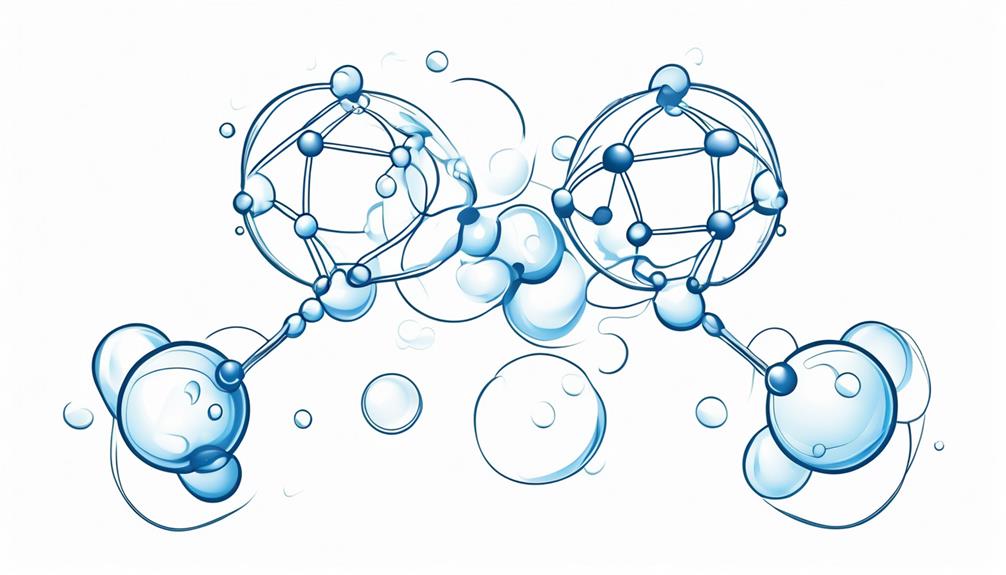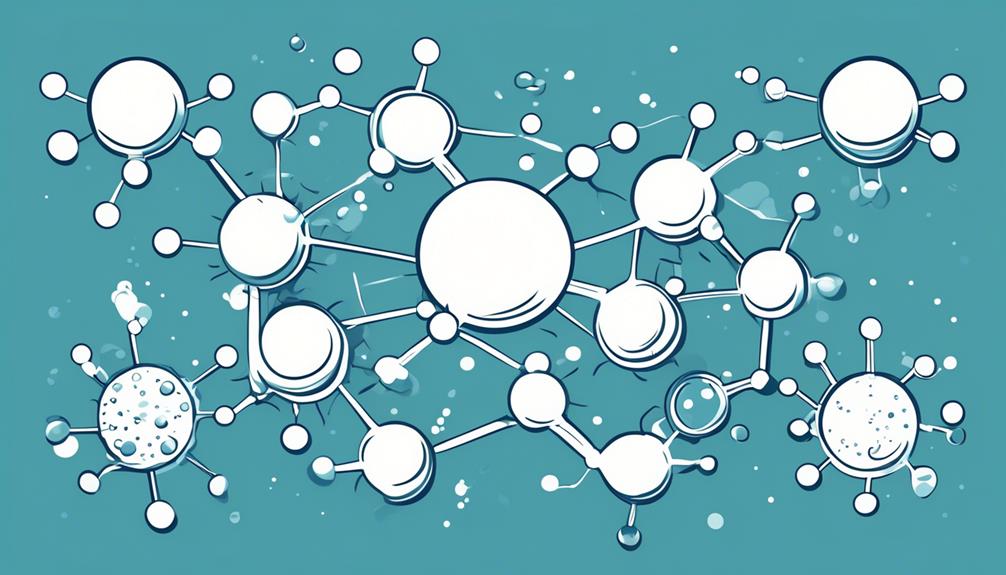Imagine a scenario where you observe two magnets. One side of the magnet attracts while the other repels. Just like those magnets, water molecules also have a similar duality, being polar in nature.
The asymmetrical distribution of electrons in a water molecule creates a unique charge separation that impacts a myriad of its properties. But why does this simple molecular structure hold such complexity within its bonds? The answer lies in the intricate dance of electrons between hydrogen and oxygen atoms, shaping the very essence of water's polarity.
Key Takeaways
- Water's polarity arises from the unequal charge distribution between oxygen and hydrogen atoms, resulting in a partial negative charge on oxygen and partial positive charges on hydrogen.
- The polar covalent bonds in water molecules lead to a positive charge near hydrogen atoms and a negative charge near the oxygen atom, allowing water to form hydrogen bonds.
- Understanding water's electron distribution and electronegativity differences between hydrogen and oxygen atoms is crucial for comprehending its unique properties and behavior.
- Water's polarity influences various important phenomena such as surface tension, capillary action, nutrient uptake in plants, regulation of temperature changes, and its role in environmental processes like the water cycle.
Definition of Water Polarity
Water polarity is a fundamental concept in chemistry that arises from the uneven distribution of charges within a water molecule. Water, a polar molecule, is formed by polar covalent bonds between oxygen and hydrogen atoms. The oxygen atom attracts electrons more strongly, leading to an unequal sharing of electrons. This results in the oxygen atom having a partial negative charge and the hydrogen atoms carrying a partial positive charge.
Due to this polarity, water molecules can form hydrogen bonds with each other. These bonds are crucial in various biological and chemical processes, influencing the unique properties of water. Understanding the polar nature of water is essential for comprehending its behavior in different contexts, such as its role as a universal solvent in biological systems and its ability to moderate temperature changes in the environment.
Structure of Water Molecules
Now, let's talk about the structure of water molecules.
The arrangement of atoms in a water molecule creates a unique shape where the hydrogen atoms carry a partial positive charge and the oxygen atom holds a partial negative charge.
This distribution of charges plays a crucial role in water's ability to form hydrogen bonds and exhibit its distinctive properties.
Molecular Arrangement in Water
With its unique molecular arrangement, water exhibits distinctive properties that stem from the polar nature of its structure. Water's bent geometry results in positively-charged hydrogen atoms and a negatively-charged oxygen atom, leading to a polar covalent bond. The unequal distribution of charges within the water molecule creates its partial dipole nature and polarity. The repulsion between lone pairs of electrons on oxygen causes the bent shape of water, contributing to its polar covalent bond.
Water molecules are attracted to each other due to their polar nature.
Hydrogen atoms share electrons with oxygen in water, forming a covalent bond.
The slightly positive hydrogen and the electrostatic force caused by the polar bond lead to unique properties of water.
Electron Distribution in Water
In the molecular structure of water, electrons are distributed unequally between the positively-charged hydrogen atoms and the negatively-charged oxygen atom, forming a polar covalent bond. This distribution results in a partial positive charge on the hydrogen atoms and a partial negative charge on the oxygen atom.
The shared electrons spend more time around the oxygen nucleus due to its higher electronegativity, creating a more negative region around oxygen and a more positive region around hydrogen. These partial charges enable water molecules to form hydrogen bonds with other water molecules or polar substances, contributing to water's unique properties.
The unequal electron distribution in water is fundamental to its polar nature, making it an excellent solvent and a crucial component for many biological processes.
Electronegativity in Water Molecules
When considering electronegativity in water molecules, you'll explore the concept of how atoms in water differ in their ability to attract electrons, resulting in a polar molecule with distinct charges.
Understanding this polarity is crucial as it influences water's behavior and its interactions with other substances, highlighting the impact of electronegativity on the unique properties of water.
Electronegativity Concept Explained
Exploring the concept of electronegativity illuminates the intricate nature of water molecules, shedding light on their polar characteristics and unique properties.
- Water molecules consist of one oxygen atom and two hydrogen atoms, forming polar covalent bonds due to differences in electronegativity.
- Electronegativity is the measure of an atom's ability to attract shared electrons towards itself in a chemical bond.
- The electronegativity difference between oxygen and hydrogen creates a partial negative charge on oxygen and partial positive charges on hydrogen, leading to the polarity of water molecules.
Understanding the electronegativity concept is crucial in comprehending why water exhibits properties like surface tension, high specific heat, and solvent capabilities.
Water Molecule Polarity
With its unique bent geometry, water molecules exhibit distinct polar characteristics due to the electronegativity difference between oxygen and hydrogen. Within a water molecule, the oxygen atom attracts electrons more strongly than the hydrogen atoms, creating a negative charge near the oxygen and positive charges near the hydrogen atoms.
This unequal distribution of charges results in a partial negative charge near the oxygen atom and partial positive charges near the hydrogen atoms. Consequently, water molecules are polar, with one side carrying a slight negative charge and the other a slight positive charge.
This polarity plays a crucial role in the formation of hydrogen bonds between water molecules, influencing water's properties and its ability to interact with other substances.
Impact of Electronegativity
The polarity of water, stemming from the electronegativity difference between hydrogen and oxygen atoms, significantly impacts its chemical behavior. This electronegativity contrast causes the electrons in the water molecule to be more attracted to the oxygen atom, giving it a partial negative charge, while the hydrogen atoms possess a partial positive charge.
This charge separation allows water molecules to form hydrogen bonds, influencing their interactions with other substances. These hydrogen bonds play a crucial role in various phenomena, such as the unique properties of water, its solvent capabilities, and the formation of ionic bonds.
Understanding the impact of electronegativity on water molecules is fundamental for grasping their behavior in biological, chemical, and environmental contexts.
Hydrogen Bonding in Water

Water's ability to form hydrogen bonds plays a crucial role in its unique properties and interactions with other substances. The water molecule's bent geometry results in positively charged hydrogen atoms and a negatively charged oxygen atom, creating a polar nature. This polarity arises from the unequal distribution of electrons within the molecule, leading to partial dipole characteristics and a polar covalent bond. The difference in electronegativity between the hydrogen and oxygen atoms causes partial positive and negative charges, enabling the formation of hydrogen bonds. Through these bonds, water can interact with other molecules, such as hydrogen fluoride, and exhibit its solvent properties. Understanding the significance of water's hydrogen bonding is essential in various contexts, including biological, chemical, and environmental studies.
| Positively Charged | Negatively Charged |
|---|---|
| Hydrogen Atoms | Oxygen Atom |
| Partial Positive Charges | Partial Negative Charges |
Impact of Water Polarity
The polarity of water significantly influences its behavior and interactions with other substances.
- Water's polarity allows for the formation of hydrogen bonds, which are crucial for its unique properties and interactions with other substances.
- The polar nature of water enables it to dissolve various solutes by interacting with their charges, making it a universal solvent.
- Despite being a polar molecule, water remains electrically neutral due to an equal number of protons and electrons.
Water's polarity plays a vital role in its ability to form hydrogen bonds, which contribute to its high surface tension, cohesion, adhesion, and many other unique properties. This polarity also facilitates the dissolution of ionic compounds through ionic bonding interactions. Understanding the polar nature of water is fundamental in various fields, including biology, chemistry, and environmental science, as it governs the behavior of water molecules in living organisms, chemical reactions, and ecosystems.
Applications of Polar Water

Polar water's unique properties find diverse applications in various natural phenomena and human activities. The water molecule's polarity, with oxygen attracting more electrons than hydrogen atoms, leads to a separation of charges, making it polar.
This polar nature influences surface tension, allowing water to form droplets, crucial for supporting small organisms like water striders. Additionally, water's polarity plays a vital role in capillary action, enabling it to move against gravity in plants and porous materials, aiding in nutrient uptake.
The high specific heat of water, influenced by its polarity, helps regulate temperature changes in oceans and living organisms, buffering against rapid fluctuations. Water's polarity also enhances its ability to dissolve substances, facilitating processes like nutrient transport.
Furthermore, the polar nature of water is integral to environmental processes such as weather patterns, erosion, and the water cycle, shaping the Fluid Earth, as researched by the University of Hawai'i.
Frequently Asked Questions
What Makes a Water Molecule Polar?
Water molecules are polar due to their bent geometry, creating positive hydrogen atoms and a negative oxygen atom. This charge distribution results in a partial dipole nature, forming polar covalent bonds essential for various interactions.
Why Is a Water Molecule Polar Quizlet?
Alright, so a water molecule is polar because of its uneven charge distribution. The hydrogen atoms are positive, the oxygen atom is negative, creating a partial dipole. This polarity is key to water's unique properties.
Why Is Water Considered a Dipolar Molecule?
Water is considered a dipolar molecule because of its unequal charge distribution with positive hydrogen and negative oxygen ends, forming polar covalent bonds. This unique property allows water to interact with other substances in a balanced manner.
What Best Describes Why Water Is a Polar Molecule?
Water is a polar molecule mainly due to its bent shape with positive hydrogen and negative oxygen ends. This unequal charge distribution, caused by differing electronegativities between hydrogen and oxygen, forms its partial dipole nature.
Conclusion
So, now you know why water molecules are polar!
Remember, 'like dissolves like,' meaning polar water molecules can dissolve other polar substances.
This unique property of water plays a crucial role in various chemical reactions and biological processes.
Embrace the polarity of water and appreciate its impact on our world.
Stay curious and keep exploring the wonders of this essential molecule!
